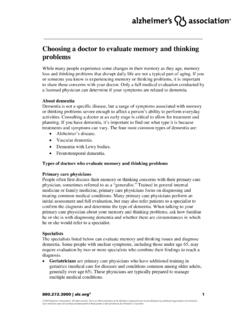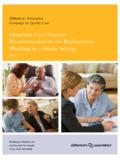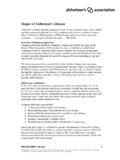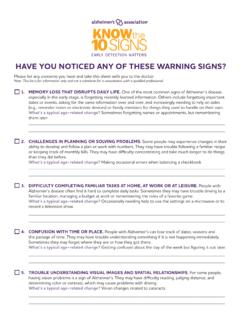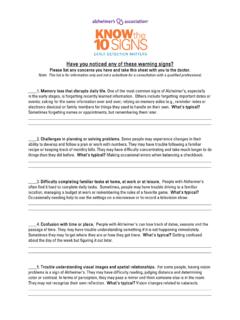Transcription of 2022 Alzheimer’s Disease Facts and Figures
1 2022 alzheimer s Disease Facts and Figures Special Report More Than Normal Aging: Understanding Mild Cognitive Impairment About this report2022 alzheimer s Disease Facts and Figures is a statistical resource for data related to alzheimer s Disease , the most common cause of dementia. Background and context for interpretation of the data are contained in the Overview. Additional sections address prevalence, mortality and morbidity, caregiving, the dementia care workforce, and the use and costs of health care, long-term care and hospice. A Special Report examines consumers and primary care physicians perspectives on awareness, diagnosis and treatment of mild cognitive impairment (MCI), including MCI due to alzheimer s Disease .
2 The statistics, Facts , Figures , interpretations and statements made in this report are based on currently available data and information as cited in the report, all of which are subject to revision as new data and information become s association . 2022 alzheimer s Disease Facts and Figures . Alzheimers Dement 2022; alzheimer s Disease Facts and FiguresSpecific information in this year s alzheimer s Disease Facts and Figures includes: Brain changes that occur with alzheimer s Disease (page 8). Risk factors for alzheimer s dementia (page 13). Number of Americans living with alzheimer s dementia nationally (page 19) and for each state (page 22).
3 Lifetime risk for developing alzheimer s dementia (page 24). Proportions of women and men with alzheimer s and other dementias (page 24). Number of deaths due to alzheimer s Disease nationally (page 30) and for each state (page 33), and death rates by age (page 35). Number of family caregivers, hours of care provided, and economic value of unpaid care nationally (page 38) and for each state (page 42). The impact of caregiving on caregivers (page 43). The roles of the paid workforce in diagnosing, treating and caring for people with alzheimer s or other dementias (page 53). National cost of care for individuals with alzheimer s or other dementias, including costs paid by Medicare and Medicaid and costs paid out of pocket (page 61).
4 Medicare payments for people with dementia compared with people without dementia (page 65). The public's awareness of mild cognitive impairment (page 85). Primary care physicians perspectives on diagnosing mild cognitive impairment (MCI) and MCI due to alzheimer s Disease (page 89). The Appendices detail sources and methods used to derive statistics in this report. When possible, specific information about alzheimer s Disease is provided; in other cases, the reference may be a more general one of alzheimer s or other dementias. 2 alzheimer s association . 2022 alzheimer s Disease Facts and Figures .
5 Alzheimers Dement 2022; Overview alzheimer s Disease or Dementia? 5 Brain Changes of alzheimer s Disease 8 Mixed Dementia 8 alzheimer s Disease Continuum 9 When Dementia-Like Symptoms Are Not Dementia 10 Treat ment s 12 Active Management of Dementia Due to alzheimer s Disease 13 Risk Factors for alzheimer s 13 Looking to the Future 17 Prevalence Prevalence of alzheimer s and Other Dementias in the United States 19 Prevalence Estimates 20 Estimates of the Number of People with alzheimer s Dementia by State 24 Incidence of
6 alzheimer s Dementia 24 Lifetime Risk of alzheimer s Dementia 24 Differences Between Women and Men in the Prevalence and Risk of alzheimer s and Other Dementias 24 Racial and Ethnic Differences in the Prevalence of alzheimer s and Other Dementias 25 Trends in the Prevalence and Incidence of alzheimer s Dementia Over Time 27 Looking to the Future 27 Mortality and Morbidity Deaths from alzheimer s Disease 30 The Effect of the COVID-19 Pandemic on Deaths from alzheimer 's Disease 31 Public Health Impact of Deaths from alzheimer s Disease 34 State-by-State Deaths from alzheimer s 34 alzheimer s Death Rates 34 Duration of Illness from Diagnosis to Death 35 Burden of alzheimer s Disease 35 Looking to the Future 36 Caregiving Unpaid Caregivers 38 Who Are the Caregivers?
7 39 Caregiving and Women 39 Race, Ethnicity and Dementia Caregiving 40 Caregiving Tasks 40 Duration of Caregiving 41 Hours of Unpaid Care and Economic Value of Caregiving 41 Health and Economic Impacts of alzheimer s Caregiving 43 Interventions Designed to Assist Caregivers 47 Trends in Dementia Caregiving 49 COVID-19 and Dementia Caregiving 503 ContentsUse and Costs of Health Care, Long-Term Care and HospiceTotal Cost of Health Care and Long-Term Care 61 Use and Costs of Health Care Services 62 Use and Costs of Long- Term Care Services 67 Medicare Does Not Cover Long-Term Care in a Nursing Home 71 Use and Costs of Health Care and Long-Term Care Services by Race/ Ethnicity 75 Avoidable Use of Health Care and Long-Term Care Services 76 The COVID-19 Pandemic and Health Care Utilization and Costs 77 Projections for the Future 79 Special Report More Than Normal Aging.
8 Understanding Mild Cognitive ImpairmentConfronting MCI and Why It Matters 81 MCI Diagnosis and Treat ment 81 MCI Due to alzheimer 's Disease : A Distinct Condition 82 MCI Due to alzheimer 's Disease Represents a Critical Turning Point in the alzheimer 's Disease Continuum 83 Understanding MCI and MCI Due to alzheimer 's Disease Today: Adult and Primary Care Physician Surveys 84 Key Findings 84 Survey Design and Research Methods 85 Survey Results 85A Path Forward: Increasing Awareness and Diagnosis of MCI and MCI Due to alzheimer 's Disease 90 Conclusion 95 Workforce Diagnosis 53 Treat ment 55 Care 55 Workforce Needs for New Therapies 56 Barriers to Developing Enough Well-Trained Members of the alzheimer s and Dementia Care Workforce 56 Looking to the Future 58 Appendices End Notes 96 References 98 alzheimer 's Disease is the most common cause of s Disease is a type of brain Disease .
9 Just as coronary artery Disease is a type of heart Disease . It is caused by damage to nerve cells (neurons) in the brain. Individuals with mild symptoms often may continue to work, drive and participate in their favorite activities, with occasional help from family members and friends. However, alzheimer s Disease is a progressive Disease , meaning it gets worse with time. How quickly it progresses and what abilities are affected vary from person to person. Medications can temporarily help neurons in the brain to communicate with each other and in that way help symptoms for varying lengths of time, but do not cure alzheimer 's.
10 As time passes, more neurons are damaged and more areas of the brain are affected. Increased help from family members, friends and professional caregivers is needed to carry out activities of daily living,A1 such as dressing and bathing, and to keep the individual safe. People may develop changes in mood, behavior or personality as a result of the thinking and memory challenges they are experiencing. One area of special concern is preventing falls, which can cause head injury, fractures and hospitalization. Preventing wandering is another area of special concern. Wandering refers to individuals walking away from a particular location and being unable to retrace their steps.
